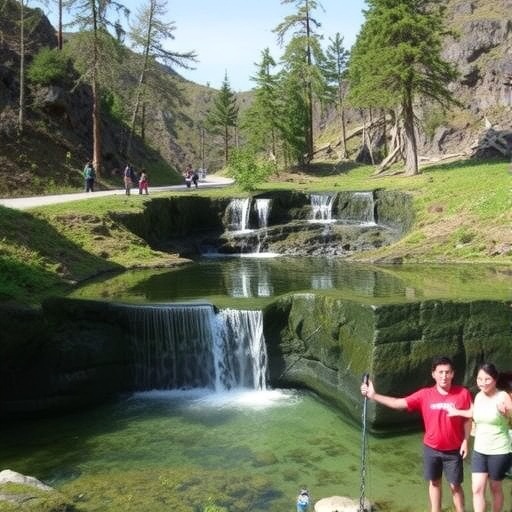Groundwater and surface water interactions play a critical role in sustaining aquatic ecosystems and managing water resources, yet understanding these complex exchanges remains a scientific challenge. A recent groundbreaking study by Lim and Jeen published in Environmental Earth Sciences unravels this intricate relationship in Osongji, Korea, through advanced hydrogeochemical profiling of the hyporheic zone. This research provides pivotal evidence deepening our comprehension of how subsurface and surface hydrological systems communicate, with implications for water resource management, pollution control, and ecosystem health.
Located in the Osongji region of Korea, the study site presents a unique setting where groundwater and surface water interfaces dynamically interact. The hyporheic zone, the narrow ecotone situated beneath and alongside stream beds where mixing of surface and groundwater occurs, has been notoriously difficult to characterize given its spatial heterogeneity and transient hydrological conditions. Lim and Jeen harnessed sophisticated hydrogeochemical techniques to delineate the fluxes and mixing patterns within this elusive zone, shedding light on the biogeochemical processes mediated therein.
Central to their approach was comprehensive profiling of water chemistry parameters along vertical and horizontal gradients within the hyporheic zone. By systematically sampling and analyzing variations in key ions, dissolved oxygen, isotopic signatures, and redox-sensitive species, the researchers were able to distinguish zones dominated by either groundwater or surface water influence. Such detailed characterization illuminated the spatial complexity of groundwater-surface water exchanges, revealing subtle gradients that conventional methods might overlook.
One of the major revelations from the study is the identification of distinct hydrogeochemical signatures corresponding to inflowing groundwater and overlying surface water. The presence of specific ion ratios and isotopic markers helped delineate groundwater discharge zones and recharge areas, highlighting the bidirectional nature of the hyporheic exchange. These findings underscore the dynamic and reciprocal interactions that sustain streamflow and aquifer recharge, challenging simplistic views of unidirectional water movement.
Moreover, the research exposes the intricate role of the hyporheic zone as a biogeochemical reactor where redox transformations actively modify water quality. The data showed variations in dissolved oxygen and redox-sensitive elements, such as nitrate and iron, which correlated with hydrologic exchange patterns. These processes are significant, as they influence nutrient cycling, contaminant attenuation, and overall ecosystem functioning, positioning the hyporheic zone as a critical environment for maintaining water quality.
The methodological rigor of this study also stands out. Lim and Jeen employed cutting-edge analytical tools including isotope hydrology and geochemical modeling, which provided robust quantitative insights into flow paths and residence times within the hyporheic zone. This integrative approach enables a nuanced understanding of how temporal variations, such as seasonal recharge events and groundwater level fluctuations, impact the interplay between groundwater and surface water.
Such insights bear direct implications for water resource management in regions dependent on both groundwater and surface water. Understanding the spatial heterogeneity and temporal dynamics of hyporheic exchanges enables more accurate predictions of streamflow sustainability, pollutant transport, and aquifer recharge potential. This knowledge is vital, particularly in the context of climate change and increasing anthropogenic pressures that threaten water availability and quality.
The Osongji study also demonstrates the value of hydrogeochemical evidence in unraveling hidden hydrological processes that are otherwise difficult to observe. By integrating field measurements with sophisticated geochemical tracers, the researchers have set a new standard for characterizing groundwater-surface water interactions in complex terrain. This paradigm could be replicated in other vulnerable catchments worldwide, advancing global understanding of freshwater ecosystems.
Equally important is the ecological perspective highlighted by the study, as the hyporheic zone functions as a habitat for diverse microbial communities and benthic organisms. The physical and chemical conditions shaped by groundwater-surface water mixing directly influence habitat quality and biodiversity within streams. The nuanced profiles generated here could inform conservation strategies aimed at preserving these critical interfaces.
The study also stresses the importance of fine-scale monitoring to capture spatial heterogeneity within the hyporheic zone. Patchy distributions of chemical constituents observed suggest that localized geochemical hotspots govern overall ecosystem responses. This finding challenges traditional sampling schemes that may overlook such microscale variability, prompting a reevaluation of monitoring protocols.
Furthermore, the research highlights potential feedback mechanisms wherein groundwater input affects surface water chemistry, which in turn influences subsurface biogeochemical reactions. This continuous interplay marks the hyporheic zone as a highly dynamic system sensitive to external environmental perturbations. Recognizing these feedback loops is crucial for anticipating ecosystem responses to environmental changes.
Lim and Jeen’s work thus serves as a keystone in bridging surface and subsurface hydrology through the lens of geochemistry. Their detailed hydrogeochemical profiling offers a blueprint for unraveling the complexities of groundwater-surface water systems, transforming the way hydrologists and ecologists perceive and manage freshwater resources. It exemplifies how multidisciplinary science can yield actionable insights into earth system processes.
In an era where freshwater availability is increasingly stressed, such comprehensive studies equip stakeholders with the knowledge necessary to balance human and ecological water needs. By exposing the often-hidden exchanges at the groundwater-surface water interface, this research empowers more sustainable, science-based water resource planning and environmental stewardship.
Ultimately, the Osongji study underscores the value of moving beyond surface observations to probe the hyporheic zone’s enigmatic subsurface processes. The revelations it offers extend far beyond Korea, holding relevance for water scientists globally seeking to safeguard freshwater ecosystems amidst mounting environmental challenges. This pioneering hydrogeochemical perspective points the way forward to a richer, more integrated understanding of our planet’s vital water cycles.
Subject of Research: Hydrogeochemical interactions between groundwater and surface water in the hyporheic zone.
Article Title: Groundwater–surface water interactions in Osongji, Korea: hydrogeochemical evidence from hyporheic zone profiling.
Article References:
Lim, S., Jeen, SW. Groundwater–surface water interactions in Osongji, Korea: hydrogeochemical evidence from hyporheic zone profiling. Environ Earth Sci 84, 691 (2025). https://doi.org/10.1007/s12665-025-12691-6
Image Credits: AI Generated




